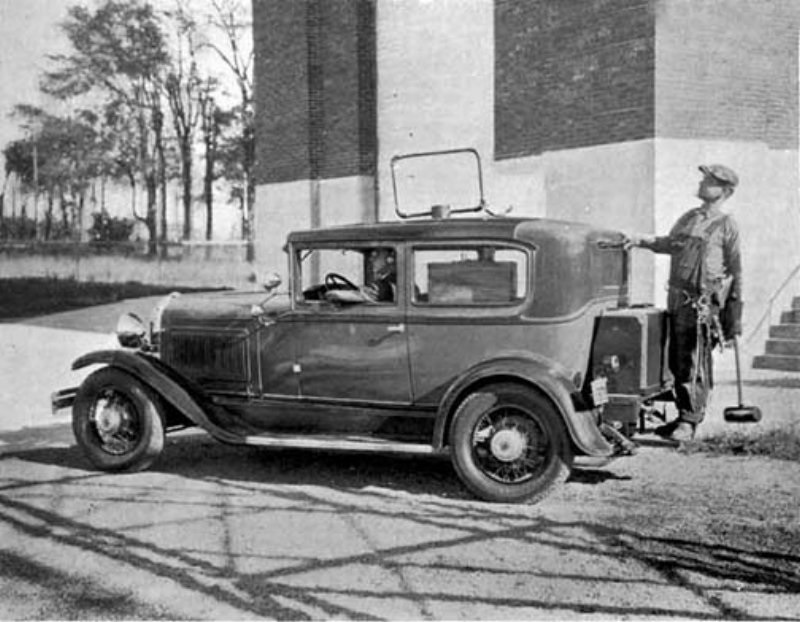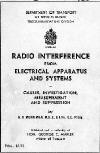
|
Spectrum Management - From the Early Years to the 1990s |
|
|
Page 08 of 26 Electrical Interference and the Public |
|
|
For discussion purposes, radio inductive interference is interference caused at the radio receiver by a signal that is induced into the receiver through its antenna or by proximity coupling, and which is caused by any sort of electrical installation or device.
Interference is not a new thing. Even before radio, people complained about it, although no quick, practical solutions were available . To illustrate, this excerpt from the history of the City of Roberval written by Rossel Vien describes an event that happened after the telephone service was installed in 1892.
[translation] "However, progress did not occur smoothly. Upon the arrival of an electric company in the village, it was discovered that telephone and electricity did not agree. When the generator was in operation, in the evening, telephone subscribers could not hear each other from one telephone to the other. The telephone people asked the electricity folks to 'stop the noise immediately' as they attributed the noise problem to induction. The electric company consulted three electricians and replied coldly: 'It is completely impossible to remove induction from the electrical current because the waves of the sympathetic currents are taken up by the telephone wires that, in turn, react sympathetically by removing from the fluid ether of the air the molecules of the bleeder currents - the primary cause of the self-induction - which, having a tendency to all travel in the same direction, prefer to move towards the telephone wires because of the affinity that exists between ohms and volts and, furthermore, because the static electricity of earth molecules contributes to this same attraction, with the result that watts will never be able to go elsewhere than in the direction of attraction of the magnetic poles of the coils in the generator and telephone boxes which are the source of these bleeder currents.'
Following this scientific response, the telephone company informed its rival in no uncertain terms, to remove all wires from its poles that had been installed without permission! The result was that the electricians installed a ground wire for the telephone line going to the electric station, which did not completely satisfy the telephone users."
This story helps to remind us of solutions that must be applied occasionally to resolve cases of interference, such as obliging radio amateurs to cease communications or limit their hours of transmission.
Usually, but not always, radio interference indicates a fault in the operation of a power system or electric appliance, or any other setup more or less resembling an electric installation.The interference could also be caused by an installation that is not faulty, in which case it is no longer interference.Some cases are the result of incompatibility between installations, but it could also be that the desired signal is too weak or that the receiver is beyond the coverage area of the transmitter, which is also not interference.
In the early 1920's, interference from power lines and streetcars was becoming an increasing problem. On the west coast, the Department had neither the manpower nor the financial means to deal with the numerous complaints. The BC Electric Company was concerned with its public image and arranged for two employees to go to Seattle to be trained by the Americans who had already developed some expertise in the field.
However, a little later, the Department decided it could no longer ignore the public pressure so it established a group for this purpose under the leadership of H.O. Merriman, engineer. After authoring many documents on this subject, he toured the country to train the staff on site. However, he soon realized that this was not enough and that interference specialists were required. Accordingly, he recruited a number of technicians, gave them the training and, around 1929, assigned each one of them to a station in the country, supplying them with a specially fitted vehicle.
Bulletin No. 2 by Horace Merriman, published by the Radio Branch, Department of Marine, in 1932, contains photographs of the first instruments used to locate sources of line interference in Canada. (Photos appended)
In 1932, more than 30,000 sources of radio interference had already been investigated.
Many terms are used to describe the various inductive interference phenomena, allowing more rapid identification of the type of source of the problem.
In radio, we use terms such as crackling, chirping, static, buzzing, frying, noise, rumbling, humming, snapping, clicking, QRN and others, depending on the vocabulary of the person complaining.
In television, inductive interference shows up as white or coloured dots, or horizontal bands across the screen. Their vertical height varies depending on the intensity of the interference. The bands roll vertically across the screen because the sweep of the television image is not quite the same as the 60 hertz frequency in the area. Usually, the television's audio channel will not be affected by inductive interference because of the technique used (FM) unless the level or intensity of the interference is very high or the source is very close to the receiver.
Some problems for listeners
In the past, it was not always easy for listeners to tune or syntonize their receivers properly. When Galena sets first appeared, some tinkering and especially patience were required to find THE sensitive spot on the Galena rock. Many people developed their skills in building receivers because the manufactured units were costly.
But when radio tubes came into use, with the new regenerative circuits, everything had to be properly adjusted, otherwise the neighbourhood would hear all kinds of whistling. Manufacturers provided specific instructions on how to tune a receiver. Below is an example published in Le Soleil on October 4, 1924, and contained in La Radio à Québec 1920-1960, published by Presses de l'Université Laval. [translation]
After connecting the batteries, antenna and ground wire correctly, provide current to the filament by turning the vernier rheostat. Start with the condensers at zero. ... With the condensers at zero, turn the amplifying condenser until you can hear a slight hum in the earphones. Then, turn the tuning condenser until the hum disappears, then adjust the amplifying condenser until the hum reappears ... While the tuning condenser is moving, many stations will be heard suddenly. If there is a singing tone when you pass a station, adjust the amplifying condenser by bringing the disk back towards zero ...
Let's just say that it was a bit different then and not nearly as easy as it is today !
|
|
|
Spectrum Management - From the Early Years to the 1990s |
|







